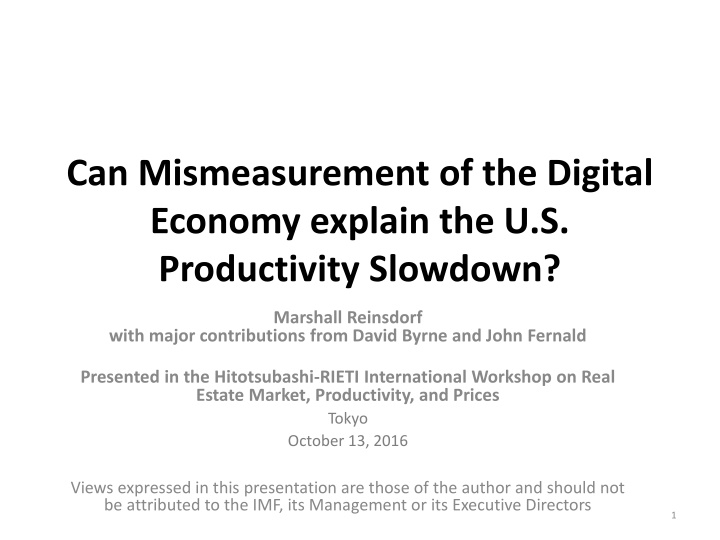
U.S. Productivity Slowdown Due to Digital Economy Mismeasurement
The presentation discusses how mismeasurement of the digital economy may explain the U.S. productivity slowdown. It highlights the pre-recession slowing of productivity growth, challenges in measuring digital advancements' impact, and the implications on GDP and technological progress. The paper evaluates alternative deflators for ICT products to address measurement errors.
Uploaded on | 1 Views
Download Presentation

Please find below an Image/Link to download the presentation.
The content on the website is provided AS IS for your information and personal use only. It may not be sold, licensed, or shared on other websites without obtaining consent from the author. If you encounter any issues during the download, it is possible that the publisher has removed the file from their server.
You are allowed to download the files provided on this website for personal or commercial use, subject to the condition that they are used lawfully. All files are the property of their respective owners.
The content on the website is provided AS IS for your information and personal use only. It may not be sold, licensed, or shared on other websites without obtaining consent from the author.
E N D
Presentation Transcript
Can Mismeasurement of the Digital Economy explain the U.S. Productivity Slowdown? Marshall Reinsdorf with major contributions from David Byrne and John Fernald Presented in the Hitotsubashi-RIETI International Workshop on Real Estate Market, Productivity, and Prices Tokyo October 13, 2016 Views expressed in this presentation are those of the author and should not be attributed to the IMF, its Management or its Executive Directors 1
U.S. Productivity Slump U.S. productivity growth slowed 3 or 4 years before the Financial Crisis Normal post-recession rebound in productivity never materialized growth rates of labor productivity and TFP still slow Other advanced economies experienced similar productivity slowdowns Had pre-2004 trend growth of labor productivity continued, U.S. GDP would have been $3 trillion higher in 2015 (2009 dollars) 2
Labor Productivity Growth Rates, U.S. Business Sector Market Producers Growth of Output per Hour, Business Sector 3.5 3.0 2.5 2.0 1.5 1.0 0.5 0.0 1995-2004 2004-2014 Source: Log-change in output per hour from official BLS data republished by Fernald (2014) 3
Productivity Slump Commentators in Silicon Valley and Wall Street argue that explanation is measurement error Technology seems to be progressing as fast as ever New digital products have increased welfare Inflation is low and corporate profits are good The numbers are too bad to be true The deflators for computers and other digital products look high compared to what could be expected from strong technological progress 4
US Computer Price Indexes, Rates of Decline Rate of Decline in U.S. Computer Price Indexes from the CPI, PPI and National Accounts (BEA) 40 35 30 25 20 15 10 5 0 1998 1999 2000 2001 2002 2003 2004 2005 2006 2007 2008 2009 2010 2011 2012 2013 2014 2015 PPI, computers CPI, computers & peripherals CPI, IT hardware and services BEA, computers and peripherals 5
Outline of Paper Byrnes, Fernald and Reinsdorf (BPEA, 2016) calculate alternative deflators for ICT products We used the alternative deflators for ICT products to adjust measured productivity growth We also adjusted for mismeasurement linked to intangibles, globalization, Internet access, and fracking These sources of mismeasurement don t help to explain the slowdown Adding unmeasured gains from the Internet and smartphones would make the total adjustment in 2004-2014 a little bit larger 6
BFR (2016) do find increasing bias in computer deflators Computer and peripheral prices Annual data Percent 5 0 -5 -10 -15 -20 -25 -30 NIPA Alternative -35 -40 -45 1960 1964 1968 1972 1976 1980 1984 1988 1992 1996 2000 2004 2008 2012 7
Factors Contributing to Rising ICT Price Mismeasurement Changing pricing policies for model turnover (Byrne, Corrado and Sichel, 2015) Technology has changed in ways that make earlier hedonic specifications obsolete (Byrne and Pinto, 2015; Byrne and Corrado, 2016) Innovations in cellular networks missed (Byrne and Corrado, 2015, 2016) Specialized equipment and software overlooked or hard to measure 8
But weights on IT Products decreased Reason for the lack of effect on the slowdown is the decline in weights of ITC products Computers weight went from 2.9% to 0.5% Semiconductor deflator adjustment raises productivity if semiconductors exported The U.S. still produces semiconductors, but imports exports giving weight 0 9
Labor Productivity Slowdown before Adjustments Growth of Output per Hour, Business Sector 4.0 3.5 3.0 2.5 2.0 1.5 1.0 0.5 0.0 1995-2004 2004-2014 11
Adjustments to Labor Productivity 4.0 3.5 3.0 2.5 Globalization Fracking 2.0 Internet access Other IT equipment and software 1.5 Computers and Comm. Equipment Official measure 1.0 0.5 0.0 1995-2004 2004-2014 -0.5 12
Adjustments to Labor Productivity 1995-2004 2004-2014 Computers and Comm. Equipment Other IT equipment and software Internet access Fracking Globalization TOTAL 0.27 0.11 0.01 0.13 0.11 0.04 0.05 0.10 0.43 0 -0.06 0.33 Note: excludes adjustment for investment in intangibles of 0.1 in 1995-2004 and consumer surplus from treating web access via smartphones as a new good 13
Total Adjustments Total of adjustments in 1995-2003 is 0.33 percent per year, but BFR also find that investment in intangibles identified by Corrado, Hulten and Sichel (2009) adds 0.1 percentage point Total adjustments in 2004-2014 = 0.43%/year Measurement effects looked at so far imply the same upward adjustment in both time periods, so don t help to explain the productivity slowdown 14
Internet-based Digital Products Free digital products, delivered over the Internet or from smartphone apps have improved consumers welfare Proposals to add these welfare gains to GPD would raise productivity, but often ignore the conceptual framework and purpose of GDP Ahmad and Schreyer (2016) find that GDP conceptual framework remains valid; practical estimation challenges are the real concern 15
Free digital services Brynjolfsson and Oh (2012) infer from the value of time spent consuming free services from Facebook, Google, Wikipedia, and YouTube they generated consumer surplus that would add 0.74 percentage points to growth in 2007-2011 But raising households productivity in home production of non-market services for own consumption does belong in a measure of market sector productivity growth Welfare gains from raising households productivity in home production would be worth measuring, just not as part of GDP 16
Free digital services Advertising-supported media businesses attract an audience or user base by offering entertainment and information that households consume National account treat advertising-supported media as providers of intermediate inputs Several proposals to include household consumption of media service in GDP 17
Free digital services Nakamura & Soloveichik (2015) propose to include a barter transaction national accounts where households sell ad-watching services Value of newly recorded household consumption equals the cost of producing the entertainment and information services Ravets (2016) discusses recording a transfer to households rather than a barter transaction 18
Free digital services Digital platforms have network effects that make user base sticky (loyal) Free digital services aimed at attracting a sticky user base can be viewed as investment in an intangible asset This would raise productivity in 2004-2014 more than in 1995-2004, offsetting some of the earlier intangible adjustment 19
Free digital services Would be useful to estimate how much money consumers have saved by replacing things they used to buy with free or low-cost smartphone apps as a kind of Paasche lower bound on cost of living index Could also use access to wider variety of Internet services as a quality adjustment factor for Internet access 20
Other digital services Peer-to-peer services such as Uber and Airbnb are already included in U.S. nominal GDP For peer-to-peer services similar to an existing service (e.g. Uber and taxis) should measure the decline the cost of living and the implied volume increase in household consumption Consumer surplus from non-comparable peer-to- peer services will be missed, as is the standard practice for new goods with no counterpart 21
E-commerce e-commerce saves time, relieves consumers of task of finding things on shelves and packing them, increases access to variety, and may offer lower prices Byrne, Fernald & Reinsdorf calibrate the Feenstra model of gains from new varieties using U.S. Census Bureau data on the share of e-commerce Adds 0.04 percent per year to growth rate of productivity in 2004-2014 Other approaches might yield bigger estimates 22
Conclusion Mismeasurement is not a significant contributor to the productivity slowdown seen in the official statistics But it would be useful to develop new measures of the growth and welfare implications of new digital products delivered over the Internet or smartphones 23






















